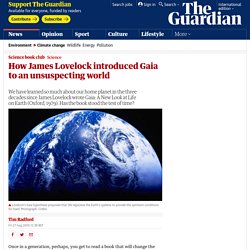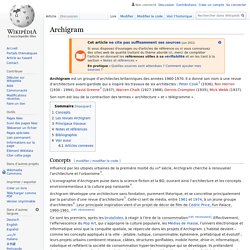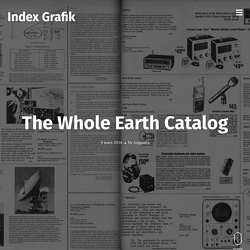

To See at Mediamatic - Mediamatic. How James Lovelock introduced Gaia to an unsuspecting world. Once in a generation, perhaps, you get to read a book that will change the way we see the world.

But it might take a whole generation to realise by how much. My copy of Gaia is a first edition from 1979: hardback price £4.95 (and there were no discounts in those days). To re-read the original text is to be reminded, in all sorts of unexpected ways, how far we have come. Its author has since morphed from J E, an "independent scientist", to James Lovelock, the world-famous author and speaker. The once-tentative Gaia hypothesis has become part of scientific orthodoxy and has been formally enshrined as the Gaia Theory, although in the US it has been dubbed Earth System Science. About – SOC. Alexandra Arènes, Soheil Hajmirbaba and Axelle Grégoire are architects, members of studio SOC.

Alexandra is a researcher in landscape architecture. She studies the Critical Zones as a new paradigm to understanding landscapes and their mapping at the scale of the Earth’s cycles: Gaia-graphy. Critical Zones. The virtual exhibition platform »Critical Zones« ++ Please note: The physical exhibition is currently closed and opens on July 24, 2020 ++ For a long time the reactions of Earth to our human actions remained unnoticed, but in recent times with the protest movement Fridays for Future climate crisis has moved into public consciousness.

The thought exhibition »CRITICAL ZONES« invites us to deal with the CRITICAL situation of the Earth in various ways and to explore new modes of coexistence between all forms of life. By now everybody knows that there is an existential threat to our collective conditions of existence, but very few people have any idea of how to cope with this new CRITICAL situation. The citizens of many developed countries appear disoriented; it is as if they were asked to land on a new territory – a new Earth – whose reactions they have ignored for a long time.
The Earth as a network of CRITICAL ZONES. Archigram. Un article de Wikipédia, l'encyclopédie libre.

Son nom est issu de la contraction des termes « architecture » et « télégramme ». Concepts[modifier | modifier le code] Influencé par les utopies urbaines de la première moitié du XXe siècle, Archigram cherche à renouveler l’architecture et l’urbanisme[3]. L'iconographie d'Archigram puise dans la science-fiction et la BD, ouvrant ainsi l'architecture et les concepts environnementaux à la culture pop naissante[4]. 1969. Design du vaisseau « Terre » – mort de la politique. – Écologie & démocratie. On présente plus rarement Fuller comme un technocrate mégalomaniaque et un dangereux idéologue!

Portfolios. Comprehensive Designer - SML Wiki. Connecting things: Broadening design to include systems, platforms, and product-service ecologies. Traditionally, design practice and design education have focused on giving form to physical things—apparel, buildings, messages, tools, and vehicles—the artifacts that constitute material culture.

These artifacts are also the material of the traditional design disciplines—apparel design, architecture, graphic design, product design, and transportation design. Recently, the field of cultural studies has turned much of its attention to physical things—not just how they are used, but also how they are designed, produced, and distributed. The Golden Record. Stewart Brand and the Whole Earth Catalog, the book that changed the world.
Stewart Brand didn't just happen to be around when the personal computer came into being; he's the one who put "personal" and "computer" together in the same sentence and introduced the concept to the world.

He wasn't just a member of the world's first open online community, the Well; he co-founded it. And he wasn't just another of those 60s acid casualties; he was the definitive 60s acid casualty. Well, not casualty exactly, but he was there taking LSD in the days when it was still legal, with the most famous hipster of them all, Ken Kesey and his Merry Pranksters. For nearly five decades, Stewart Brand has been hanging around the cutting edge of whatever is the most cutting thing of the day. Largely because he's discovered it and become fascinated with it long before anyone else has even noticed it but, in retrospect, it does make him seem like the west coast's answer to Zelig, the Woody Allen character who just happens to pop up at key moments in history. The Complicated Legacy of Stewart Brand’s “Whole Earth Catalog”
The Whole Earth Catalog – Index Grafik. « La culture libre, tout comme l’informatique, puise ses origines dans l’évolution des communautés hippies au début des années soixante-dix.

En effet, les valeurs de cette contre-culture et les théories cybernétiques de Norbert Wiener ou Marshall McLuhan ont bon nombre de points en commun. La quête spirituelle hippie qui cherche à élargir le champ de la conscience et à inventer de nouvelles manières de se lier aux autres — à travers les drogues psychédéliques par exemple — a trouvé une résonance dans les théories de village global. C’est par exemple avec l’emblématique Whole Earth Catalog de Stewart Brand que commencent à se rencontrer contre-cultures et technologies numériques.